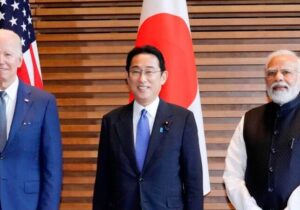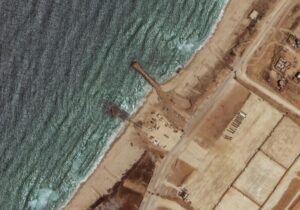On November 1st, as the State of Israel mourned her dead and tallied her hostages from the most horrific pogrom since the Shoah, Rutgers University law professor Noura Erakat, one of the Jewish state’s foremost academic accusers, thundered the following with extreme insensitivity at the Palestinian literary festival at Union Theological Seminary in New York:
“Israel has no right to self-defense against [Gazan] territory that it occupies…Should I explain that [as] people fighting against colonial domination, alien occupation, and racist regimes, Palestinians have a right to use armed force so long as it’s regulated by the laws of war?”
Foremost among numerous severe distortions of natural right and international law compressed within her leading question is the baseless allegation that racism of sort accounts for the legal order, foreign relations, and/or wartime conduct of the State of Israel.
Israeli Zionism, to begin at the modern beginning, is indeed a political theory of land and people, but not of color or blood. The Jewish State (2011 [Der Judenstaat, 1896]) of Theodor Herzl, in its principal formulation, states, “No nation on earth has survived such struggles and sufferings as we have gone through” (37). He continues, “The distinctive nationality of Jews neither can, will, nor must be destroyed” (39, emphases added). Amid further theoretical discussion of the self-sustaining character of Jewish identity and anti-Semitic persecution, Herzl explains, “A State is formed, not by pieces of land, but rather by a number of men united under sovereign rule. The people is the subjective, land the objective foundation of a state, and the subjective basis is the more important of the two” (67). Herzl organized the mass migration of European Jewry to protectorate Palestine according to this intelligent design; and although he personally would not enter the Promised Land, the eventual Israeli Declaration of Independence (14 May 1948) credited him with envisioning, “the right of the Jewish people to national rebirth in its own country” (emphases added) within ERETZ YISRAEL. Shortly thereafter, the pivotal Israeli Law of Return (1970 [1950], 4.b) defined JEW as a child—like Moses—of a Jewish mother, or as a covenanter—like Ruth—with the Jewish LORD, but who in either case does not practice any other religious system, unlike the New Testament Apostles Peter, James, or John. Zionist political theory and Israeli comparative law are therefore certainly exclusivist, but not racist.
Israeli public policy, meanwhile, is perhaps more willfully anti-racist than that of any other parliamentary state, a dissenting opinion requiring the provision of otherwise distasteful ethnographic clarifications. Three main clans comprise international Jewry: the trans-Atlantic Ashkenazi, the Iberian Sephardic, and the oriental Mizrahim, who have respectively white, olive, and sandstone complexions, and who are sorted respectively into the Israeli bourgeois, managerial, and proletarian classes. The first were both the victims of the German Reich and the founders of the Jewish state; and they have spent decades painstakingly adjusting Israeli policy in order to successfully assimilate the different groupings, an intention even more pronounced with regard to the dramatic outreach to the mysterious “lost tribes” apparently living continually as Jews in remote locations since Old Testament times. Following rabbinical authentication of Ethiopian Jewry in the 1970s, the Mossad organized audacious exfiltration operations to rescue said black people from the famine and violence ravaging the horn of Africa and then resettle them in Israel, where today they are often profiled on sympathetic social media. Migration and assimilation is also encouraged with regard to the Bene Menashe, a group of ethnically Indian Jews from northeastern India. Obviously, such policies completely rebut any misrepresentation of Israel as a racist state or society.
Nor has racial animus, as such, ever been formally alleged by Israel’s Arab Palestinian enemies either, beginning with a Palestinian National Charter (1968) that reads, “The Palestinians are those Arab nationals who, until 1947, normally resided in Palestine…Anyone born, after that date, of a Palestinian father…is also a Palestinian” (5, emphasis added). Describing Judaism in passing as a religion rather than as a nation (20), the document continues, relying heavily upon Marxist imaginary, “Israel is the instrument of the Zionist movement, and geographical base for world imperialism placed strategically in the midst of the Arab homeland to combat the hopes of the Arab nation for liberation, unity, and progress” (22, emphases added). Twenty years later, the UN General Assembly formally approved (A/43/827) a Palestinian independence declaration outlining the “national rights of the Palestinian people” as unhindered return, self-determination, and sovereignty, with the PLO as sole legitimate government.
To its Maoist left, the Popular Front for the Liberation of Palestine likewise states in its manifesto Resistance until Victory (1969): “The Palestinian liberation movement is not a racial movement with aggressive intentions against the Jews…Its object is to destroy the State of Israel as a military, political, and economic establishment which rests on aggression, expansion, and organic connection with imperialist interests in our homeland” (X). Within such Marxist analysis, class conflict—not racial conflict—is always and everywhere responsible for social injustice; and consequently the Popular Front has never imputed Israeli militarism to supposed racial differences between Jews and Arabs. “The basic consideration in our view of the revolutionary forces on the Palestinian level,” continues the RED-GREEN PFLP, “is the understanding that the workers and peasants are the basic tool for the revolution” (IV).
Finally, the theoretical analysis along with the diabolical wickedness of Hamas must not be ignored. Although racial animus is twice, somewhat passively alleged against “the Zionist project” in the Hamas ‘Document of General Principles and Policies’ (1 May 2017 [preamble, 14]), their fundamentally religious worldview is otherwise made abundantly clear. “The Islamic Resistance Movement [HAMAS] is a Palestinian Islamic national liberation and resistance movement…Its frame of reference is Islam, which determines its principles, objectives, and means” (1). The jihadists continue, “Islam—for Hamas—provides a comprehensive way of life and an order that is fit for purpose at all times and in all places” (8). What are today obsessively described as racial differences are completely absent from both Islamic theology and law, being a world religion. The Hamas manifesto otherwise accepts the PLO definition of Palestinian (4-7), but categorically rejects all international mediation (21) and assigns peculiar religious significance to Jerusalem (10-11), whilst foreshadowing its eventual murderous incursion thus: “The Palestinian cause in its essence is a cause of an occupied land and a displaced people” (12, emphasis added). Consequently, “Hamas rejects any alternative to the full and complete liberation of Palestine, from the river to the sea” (20).
Amid the renewed war in the Middle East, in conclusion, the gross incompetence of the Israeli government, the extreme venality of the Israeli Prime Minister, the dubious effectiveness of Israeli air power, the violent extremism of Likud/Lehi Israeli settlers, together with the bewildered impotence of the Biden administration and, above all, the Arab Palestinian HECATOMB, though not genocide, are all equally valid and urgent discussion questions. But the allegation of racism so characteristic of the anti-Israeli signs, rallies, and encampments is analytically unsound, empirically unsubstantiated, and politically insincere; wherefore it ought to be suspended indefinitely. And I will shake all nations, and the desire of all nations shall come (Haggai 2:7).






